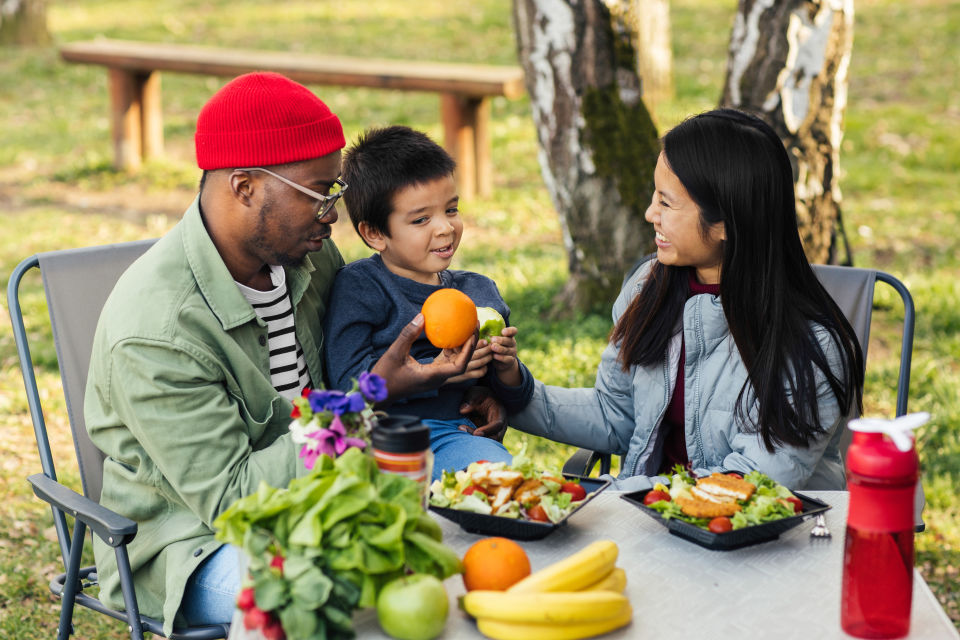Offering a mix of different healthy snacks throughout the day can help toddlers and preschoolers get the important fruits, vegetables, protein, fiber, and vitamins that they need to support their developing bodies.

Children ages 1–5 years old might need about 1–3 snacks per day in addition to their regular meals. This can help curb hunger throughout the day, which can improve their mood and energy levels.
When organizing healthy snacks for your child, here are some important guidelines to consider:
Focus on whole foods: Look for snacks that are whole foods, which means that they are as close to their natural state as possible, like fruits, vegetables, whole grains, and lean proteins. By choosing whole foods, your child gets the most nutrients and health benefits.
Limit added sugars: Avoid snacks that are high in added sugars, such as candy, sugary drinks, and packaged snacks like cookies and chips. Instead, go for naturally sweet options like fresh fruit or unsweetened yogurt.
Include healthy fats: Healthy fats are important for brain development and can help keep toddlers and preschoolers feeling full and satisfied. Good sources of healthy fats include nuts, seeds, avocados, and olive oil.
Think about texture: Toddlers and preschoolers are often picky eaters and may have strong preferences for certain textures. Offer a variety of textures, such as crunchy veggies, smooth dips, and soft fruits, to keep things interesting. If you are experimenting with harder foods like celery or carrots, it’s recommended that you cut them into bite-sized pieces and supervise your child to ensure they chew their food correctly to avoid choking.
Keep portions small: Toddlers and preschoolers have small stomachs and may not need as much food as adults. Offer small portions of snacks, and let your child decide when they're full.
Encourage healthy eating by using positive words for healthy foods: Children are influenced by the words and attitudes of the adults around them. If caregivers use negative language around healthy foods, children may be discouraged from trying them. By promoting healthy eating in a fun and engaging way, caregivers can help their children develop healthy habits that will benefit them throughout their lives. For example, instead of saying: “I know vegetables are gross, but you have to eat them anyway,” you can try saying: “I love how crunchy these carrots are! Want to try one?" or "Eating colorful fruits and vegetables can make us feel great and give us lots of energy!"
We’ve included a few healthy snack ideas that are quick to prepare and packed with great nutrients to support your growing child.
Ingredients
¾ cup dried chickpeas, rinsed, or 1 (15-ounce) can chickpeas, drained
⅓ cup fresh lemon juice (from about 2 lemons)
2 tablespoons tahini (if you don’t have tahini, you can substitute it with 2-4 tablespoons of water. Adjust the amount to create the consistency you want.)
3 tablespoons extra-virgin olive oil
2 cloves garlic, finely minced
Celery sticks, carrot sticks, jicama sticks, broccoli florets, radishes, green beans, and/or crackers, in any combination, for dipping
Preparation
Prepare the chickpeas:
If using dried chickpeas, put them in a saucepan, add water to cover them by 2 inches, and place over medium-high heat. Bring to a boil, turn down the heat to a simmer, cover, and cook until tender, 1½ to 2 hours. Drain the beans, keeping the cooking liquid to use in step 3. (The chickpeas can be cooked a day ahead.)
If using canned chickpeas, put them in a colander, rinse well under cold running water, and drain.
In a blender or food processor, combine the chickpeas, lemon juice, tahini or water, 2 tablespoons of olive oil, and the garlic, and process until smooth, adding 2 to 3 tablespoons cooking liquid or water as needed to make a creamy paste.
Transfer the dip to a shallow serving bowl and drizzle with the remaining 1 tablespoon of olive oil.
Arrange the vegetables and/or crackers on a platter or plate and serve with the hummus.
Ingredients
1 cup seedless green grapes
1 cup seedless red or purple grapes
8 ounces Monterey Jack cheese
8 ounces of mild cheddar cheese
12 (10-inch) skewers, to be used with caution and supervision (if using shorter skewers, reduce the number of grapes). Some parents prefer to use pretzel sticks instead of skewers so their child can just bite right into them.
Preparation
Wash the grapes, and remove the stems.
Slice the cheese into ½-inch cubes. You should have 24 cubes in total.
Carefully thread a green grape and then a red grape sideways onto a skewer, and follow them with a cube of white cheese. Thread two more grapes, one green and one red, onto the skewer, and follow them with a cube of yellow cheese. Repeat until you have 12 filled skewers.
Refrigerate the skewers until you are ready to serve. Just before serving, be sure to cut off the sharp end of each skewer with scissors.
Ingredients
1½ cups unsweetened almond milk
15 fresh strawberries, stems removed, or ¾ cup frozen strawberries
2 ripe bananas, peeled and cut up
Preparation
In a blender, combine the almond milk, strawberries, and bananas. Process on high speed until smooth, about 45 seconds.
Divide the smoothie evenly among five glasses.






